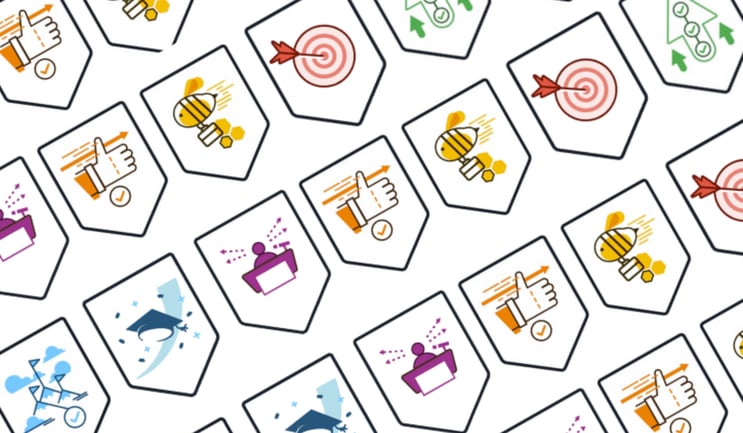
At one time, grades and the promise of a bachelor’s degree were enough to keep college students engaged toward meeting their academic and professional goals. These days, Generation Z – who came of age in a digital world with more distractions than ever before – needs more. This is where micro-credentials and digital badging come into play.
The Rise of Micro-Credentials and Gamification
Micro-credentials refer to professional and academic credentials that can be achieved by students alongside and in addition to their formal degree program. The use of gamification, often used to develop micro-credentialing programs to increase student and employee motivation, is part of a trend that gained momentum in the 2010s. Gamification, which describes applying game-like features to non-game activities, is now used in multiple facets of our lives, from wearable technology to employee training. It all boils down to basic human psychology.
If you tend to get distracted easily by a game of Words with Friends, for example, this is a testament to the power of gamification. Kids and adults alike spend hours playing video games. Even those of us not into traditional video games enjoy getting caught up in games on our phones, from Candy Crush to Tetris. Games are fun and addictive; these eight human drives help to explain our hunger for what games can provide.
- Meaning: feeling that our actions have purpose
- Accomplishment: achieving and overcoming challenges
- Empowerment: having control over our own destinies and goals
- Ownership: having a sense of possession
- Social Influence: engaging with and learning from others
- Scarcity: wanting things in limited supply not easily obtained
- Unpredictability: wanting certainty to know what will happen
- Avoidance: avoiding negative consequences
The Power of Digital Badging in Higher Education
Leaders in higher education have caught on to the gamification trend, using it in various steps along the way from improving engagement to retention. Research points to the use of gamification techniques, such as digital badging, in increasing student motivation and engagement across colleges and universities of all sizes.
The results of a 2021 survey from the University Professional and Continuing Education Association (UPCEA) show that 92% of leaders in higher education support the use of micro-credentials. Breaking the data down further, 88% of higher education administrators feel that micro-credentialing incentives align with their institution’s strategic goals.
An undergraduate education that awards a bachelor’s degree typically takes four years. As higher education leaders are now well aware, the promise of a degree is not always enough to keep students engaged, especially as four-year degree programs have come under fire for ever-increasing tuition and for failing to adequately prepare graduates with the top skills that employers seek.
Digital badging provides a long-term solution to student engagement by engaging them more in the short term. By giving students more power over their individual goals, these programs can reward them for completing targeted activities. As a result of implementing digital badging solutions, higher education institutions are witnessing more students than ever become engaged both in class and on campus.
Implementing Digital Badging on Your Campus
Intrigued about the power of digital badging and its use in improving student development and engagement? You are likely wondering how to implement the practice at your school. First, it’s important to become familiar with these key concepts associated with digital badges, or open badges, a specific type of digital badge system, according to 1EdTech:
- Open Badge: verifiable, portable digital badges with embedded metadata regarding skills and achievements
- Issuer Profile: the awarding individual or organization
- BadgeClass: a single achievement recognized by the Issuer
- Assertion: the record of an individual’s achievement of a specific badge
- Issuer: application enabling BadgeClasses creation and the issuing of Assertions to earners
- Displayer: application displaying Open Badges with associated metadata and offering verification functionality
- Host: application with the ability to import, export, aggregate and publicly host Open Badges for earners
When implementing digital badges, you must be knowledgeable of the Open Badges standard, which describes the free, publicly available technical specifications for creating, issuing, endorsing, verifying and exchanging interoperable Open Badges. Open Badges 2.0 is the latest version of the standard, first launched by the Mozilla Foundation before being taken over by IMS Global Learning Consortium.
Additionally, when implementing your digital badge strategy and design, it’s important to consider available features and determine which ones best support and meet your needs. Open badges support a selection of features, including:
- Alignment: optional URLs that point to competencies or academic standards
- Criteria: detailed information about the requirements needed to earn the badge
- Endorsement: support from third parties regarding the skills represented by each badge
- Multi-lingual: tags which declare the language used; users can opt for digital badges to be available in multiple languages
- Revocation: option to revoke digital badges if, for example, a GPA is not maintained
- Verification: available verification methods provide metadata about the badge and recipient
Now that we’ve covered the basics, let’s discuss five ways to implement digital badging on your campus.
1. Implement digital badges as stackable macro- and micro-credentials
Digital badges can be used for a variety of macro- and micro-credentials. According to a 2016 study from UPCEA, 94% of the 190 institutions surveyed issue alternative credentials in some form, with digital badges used more often than ever before to recognize such various credentials.
The idea of “stackability” refers to the acquisition of digital badges on the path to a particular micro-credential, such as a certificate or a minor area of study, or a macro-credential, most commonly a degree, as noted by the AACSB.
2. Use digital badges as tools for assessment and accreditation
Digital badges can be a helpful tool for assessment and accreditation. When they are used to track co-curricular student engagement, this data can be used as evidence to benefit university accreditation efforts.
When digital badges are used in university competency frameworks, the data gleaned from tracking the issuing of digital badges across the university can assist with accreditation efforts, especially since the data shows evidence of students’ acquisition of skills that align with a university’s core competencies to help students acquire today’s most in-demand skills.
Illinois Institute of Technology partnered with Suitable to develop a better way to help the university meet the Higher Learning Commission’s ongoing accreditation standards. Through implementing digital badges, the school was able to track and analyze its co-curricular engagement data to show not only that students were engaging but also how they were engaging and what types of skills they developed as a result.
3. Employ digital badges for skill and competency frameworks
According to the AACSB, two best practices for designing successful competency frameworks can be accomplished with digital badging. This includes providing clear pathways toward valued and validated credentials, whether in the form of a degree or certificate, as well as clear evidence of gained knowledge or knowledge application across various proficiency levels.
These days, including outside the classroom experiences in one’s resume is not enough if the skills acquired are not clearly articulated. They need to be, because many of them are what employers look for in new hires. Digital badges are a way to document evidence of learning taking place outside the classroom, whether in on-campus activities or from internships or study abroad programs.
Purdue University instituted a digital badge program with help from Suitable to incentivize students to engage with its CareerBound program, used to measure skill acquisition and proficiency in core competencies aligned with the National Association of Colleges and Employers (NACE).
4. Utilize digital badges as incentives for co-curricular programs
Digital badges can also be used to motivate students to take part in co-curricular programs. Not every student has the self-motivation necessary to seek out such programs, especially since many college students struggle to balance the workload from their classes with their extracurricular interests. With tests and deadlines, some may easily forgo their co-curricular interests.
Through the power of gamification, working toward individual goals obtained by digital badge acquisition makes completing these activities feel more like a game, giving students that extra incentive to push through and achieve a better balance. One feature of digital badges are endorsements, where third parties, such as professional associations or internship supervisors at companies, show support for obtaining the skill that a particular badge represents.
Moravian University, which partnered with Suitable to create their digital badge incentive program, offers its students the opportunity to obtain digital badges for attending campus events, joining a campus organization or club, participating in intramural sports or working with the Career Development Office.
5. Incorporate digital badges as part of a class
Digital badges can even be used as an incentive to motivate students within the classroom. It’s long been known that grade school teachers use incentives to motivate students. Just because college students are adults pursuing degrees, this doesn’t mean that they also can’t benefit by a motivational push.
These five examples show how digital badges can be implemented to meet institutional goals, including improving engagement and retention and enhancing student development and skill acquisition. The long-term benefits of using digital badges at your own college or university are made even clearer by learning how other higher learning institutions have incorporated them in their efforts.


